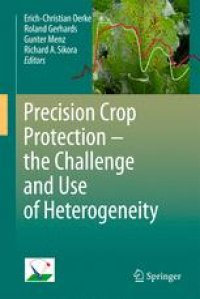
Ebook: Precision Crop Protection - the Challenge and Use of Heterogeneity
- Tags: Agriculture, Remote Sensing/Photogrammetry, Geotechnical Engineering & Applied Earth Sciences, Entomology
- Year: 2010
- Publisher: Springer Netherlands
- Edition: 1
- Language: English
- pdf
Precision farming is an agricultural management system using global navigation satellite systems, geographic information systems, remote sensing, and data management systems for optimizing the use of nutrients, water, seed, pesticides and energy in heterogeneous field situations. This book, generated by scientists from a broad range of scientific disciplines, provides extensive information on the state-of-the-art of research on precision crop protection and recent developments in site-specific application technologies for the management of weeds, arthropod pests, pathogens and nematodes. It gives the reader an up-to-date and in-depth review of both basic and applied research developments. The chapters discuss I) biology and epidemiology of pests, II) new sensor technologies, III) applications of multi-scale sensor systems, IV) sensor detection of pests in growing crops, V) spatial and non-spatial data management, VI) impact of pest heterogeneity and VII) precise mechanical and chemical pest control. Examples for the use of technologies are given for the management of pests which enable growers to vary application timing and dosage, and to optimize pesticide mixtures or intensity of mechanical weeding according to the spatial and temporal variability of pests.
Precision farming is an agricultural management system using global navigation satellite systems, geographic information systems, remote sensing, and data management systems for optimizing the use of nutrients, water, seed, pesticides and energy in heterogeneous field situations. This book, generated by scientists from a broad range of scientific disciplines, provides extensive information on the state-of-the-art of research on precision crop protection and recent developments in site-specific application technologies for the management of weeds, arthropod pests, pathogens and nematodes. It gives the reader an up-to-date and in-depth review of both basic and applied research developments. The chapters discuss I) biology and epidemiology of pests, II) new sensor technologies, III) applications of multi-scale sensor systems, IV) sensor detection of pests in growing crops, V) spatial and non-spatial data management, VI) impact of pest heterogeneity and VII) precise mechanical and chemical pest control. Examples for the use of technologies are given for the management of pests which enable growers to vary application timing and dosage, and to optimize pesticide mixtures or intensity of mechanical weeding according to the spatial and temporal variability of pests.
Precision farming is an agricultural management system using global navigation satellite systems, geographic information systems, remote sensing, and data management systems for optimizing the use of nutrients, water, seed, pesticides and energy in heterogeneous field situations. This book, generated by scientists from a broad range of scientific disciplines, provides extensive information on the state-of-the-art of research on precision crop protection and recent developments in site-specific application technologies for the management of weeds, arthropod pests, pathogens and nematodes. It gives the reader an up-to-date and in-depth review of both basic and applied research developments. The chapters discuss I) biology and epidemiology of pests, II) new sensor technologies, III) applications of multi-scale sensor systems, IV) sensor detection of pests in growing crops, V) spatial and non-spatial data management, VI) impact of pest heterogeneity and VII) precise mechanical and chemical pest control. Examples for the use of technologies are given for the management of pests which enable growers to vary application timing and dosage, and to optimize pesticide mixtures or intensity of mechanical weeding according to the spatial and temporal variability of pests.
Content:
Front Matter....Pages i-xxiv
Front Matter....Pages 1-1
Soil Heterogeneity and Crop Growth....Pages 3-16
Spatial and Temporal Dynamics of Plant Pathogens....Pages 17-25
Front Matter....Pages 27-50
The Use of Laboratory Spectroscopy and Optical Remote Sensing for Estimating Soil Properties....Pages 51-64
Sensing of Photosynthetic Activity of Crops....Pages 65-65
Remote Sensing for Precision Crop Protection – A Matter of Scale....Pages 67-85
Detection and Identification of Weeds....Pages 87-99
Detection of Fungal Diseases Optically and Pathogen Inoculum by Air Sampling....Pages 101-118
Remote Sensing for the Detection of Soil-Borne Plant Parasitic Nematodes and Fungal Pathogens....Pages 119-134
Front Matter....Pages 135-149
Spatial Data Handling and Management....Pages 151-165
Decision Rules for Site-Specific Weed Management....Pages 167-182
Model Validation and Use of Geographic Information Systems in Crop Protection Warning Service....Pages 183-202
Front Matter....Pages 203-203
Front Matter....Pages 205-222
Front Matter....Pages 223-239
Providing Precision Crop and Range Protection in the US Northern Great Plains....Pages 241-258
Site-Specific Detection and Management of Nematodes....Pages 259-276
Precision Disease Control in Bed-Grown Crops....Pages 277-277
Economic Evaluation of Precision Crop Protection Measures....Pages 279-294
Back Matter....Pages 295-310
....Pages 311-321